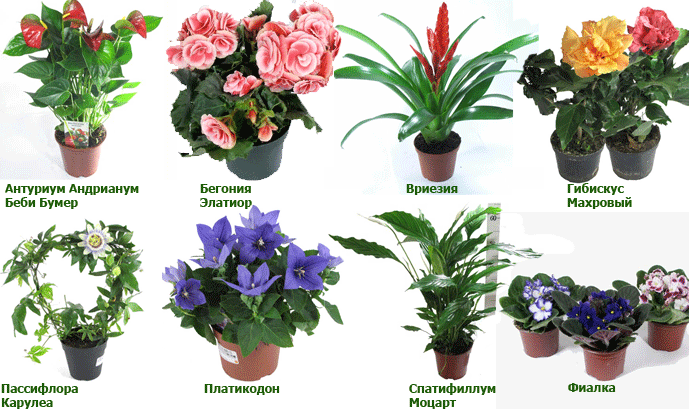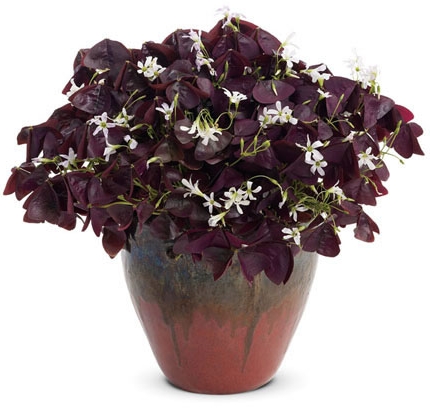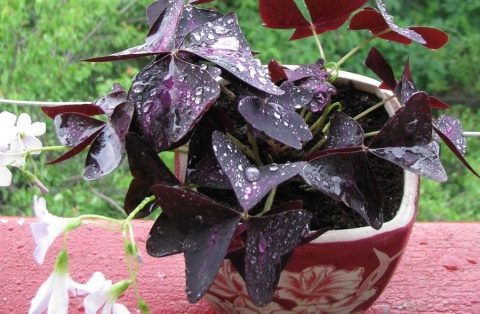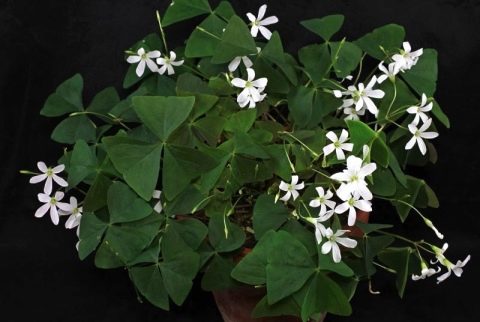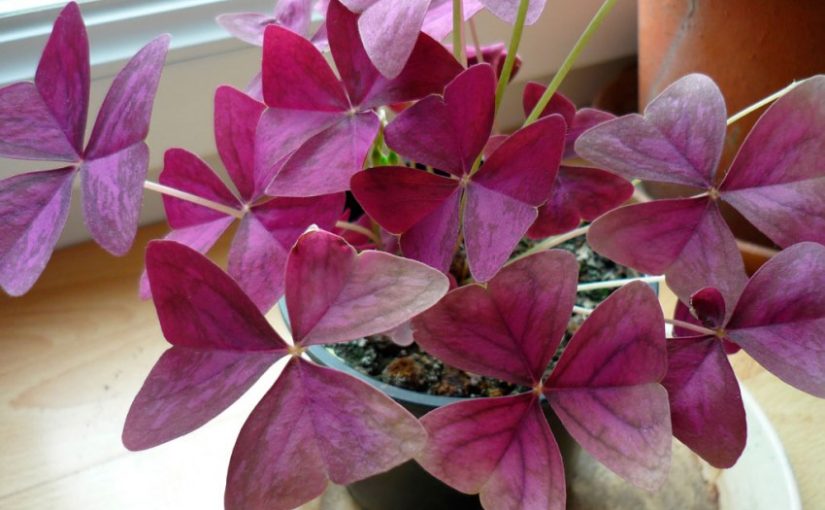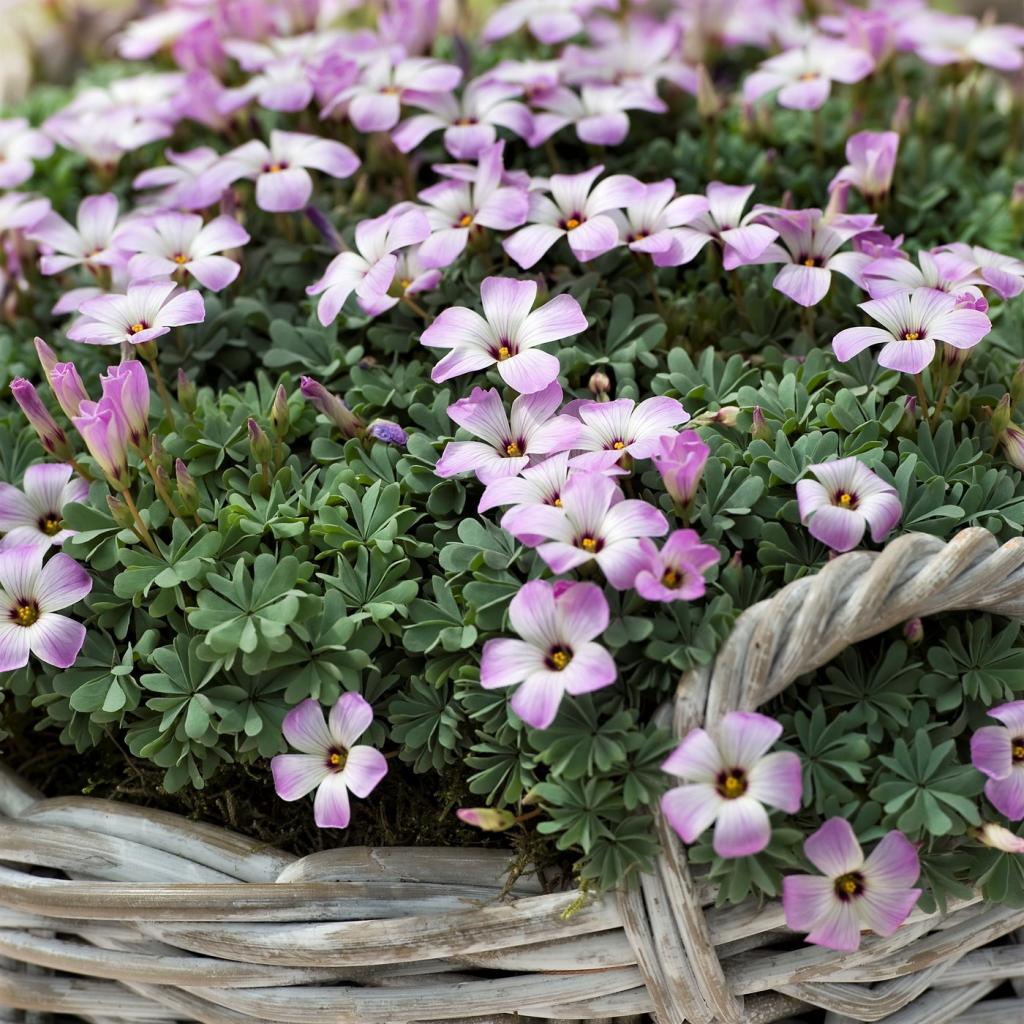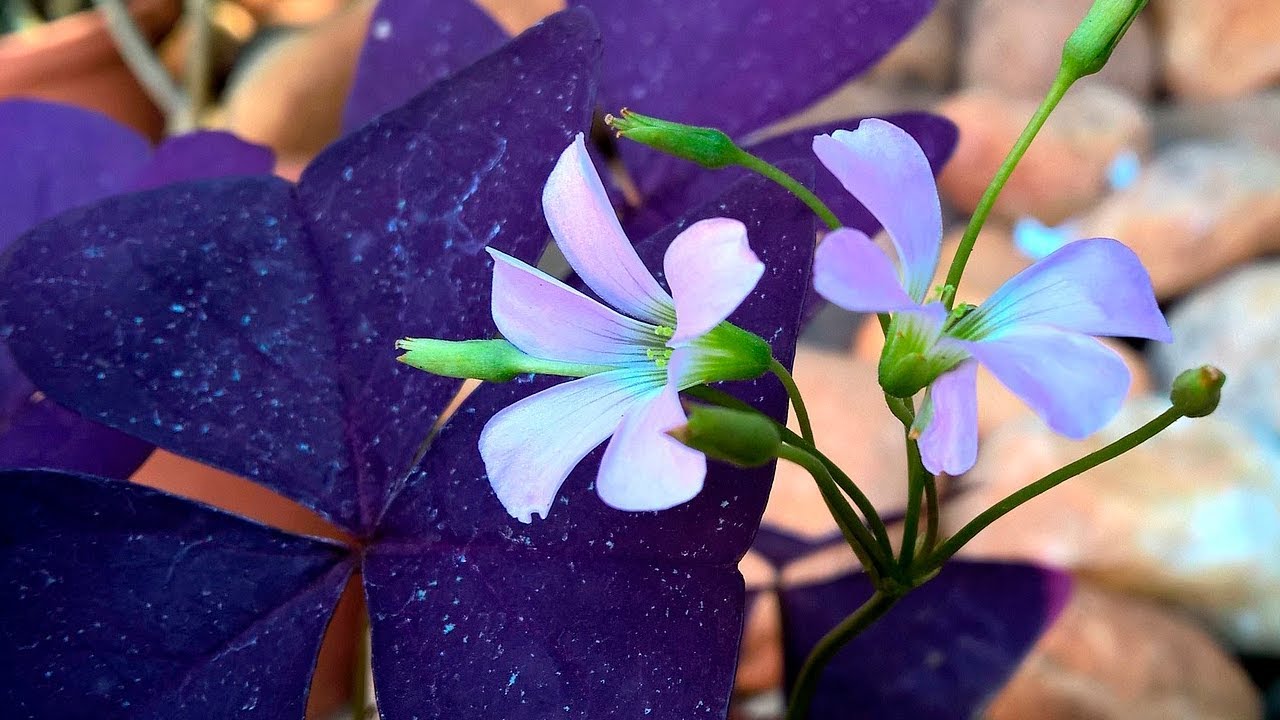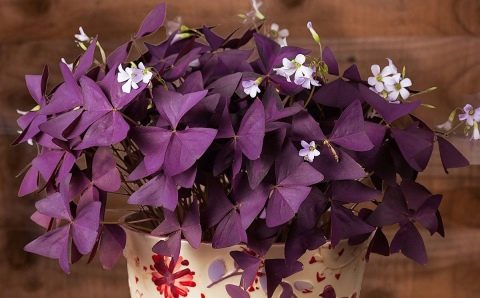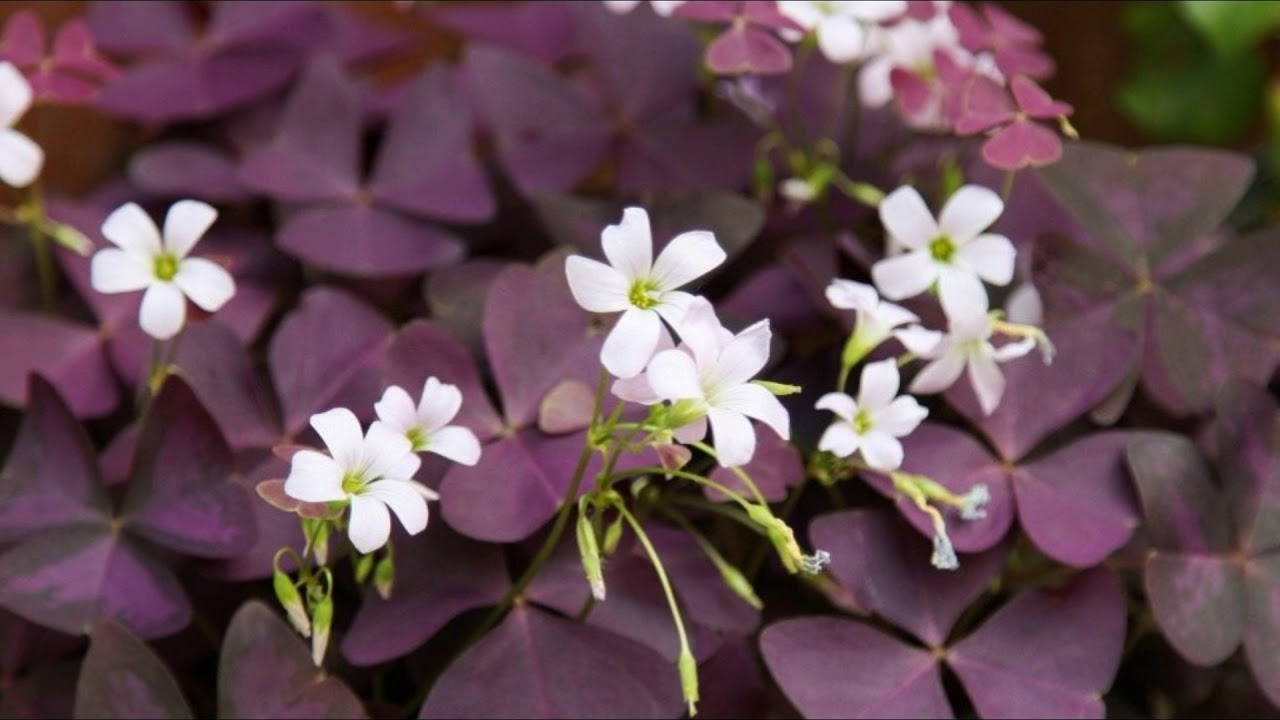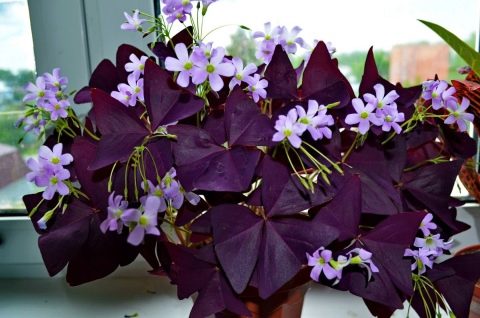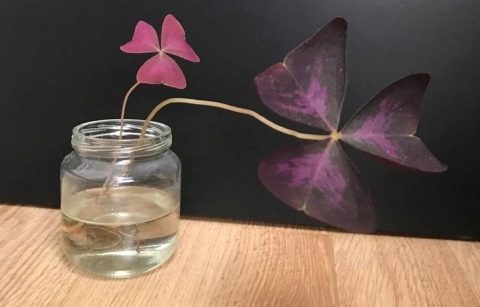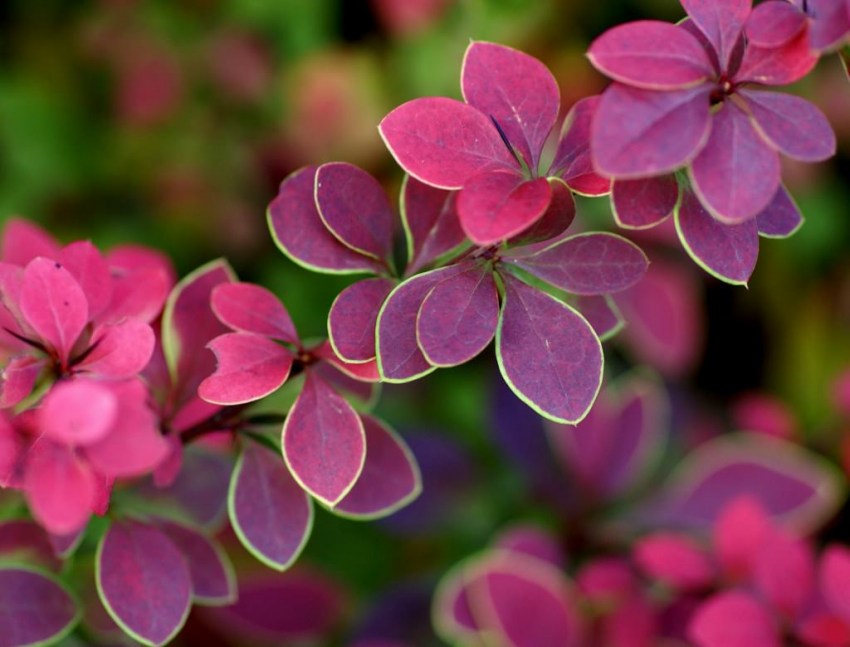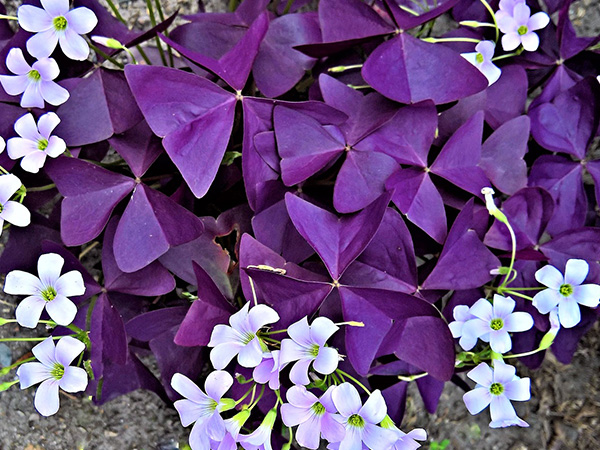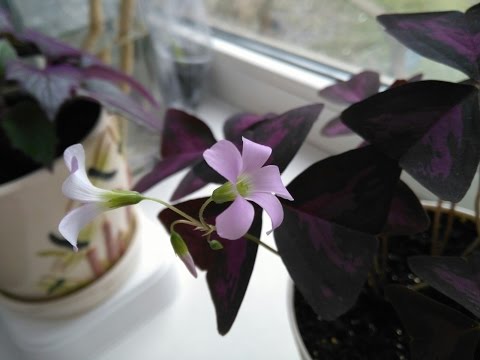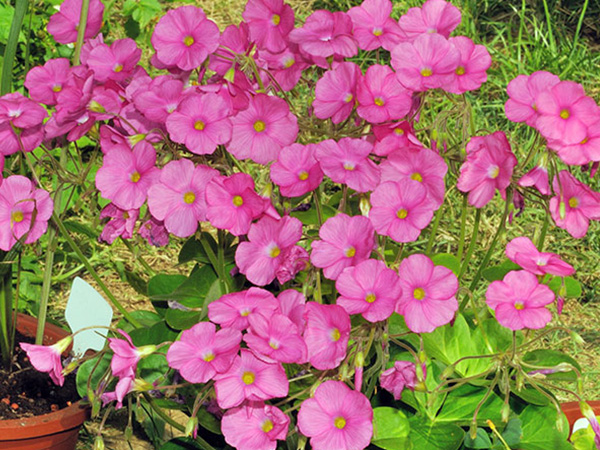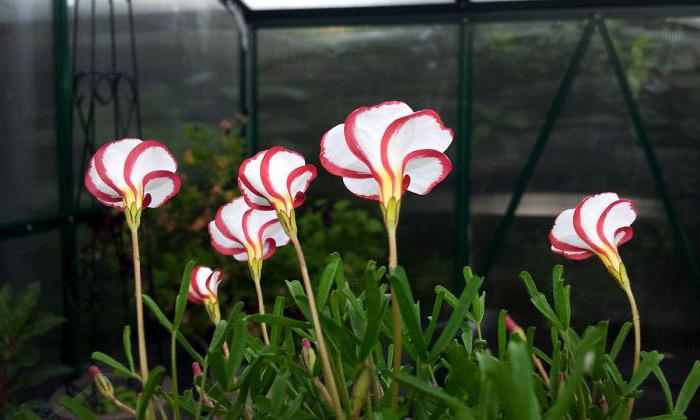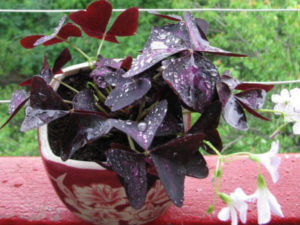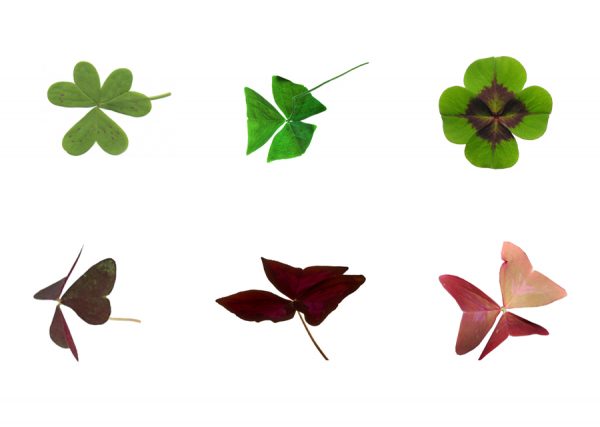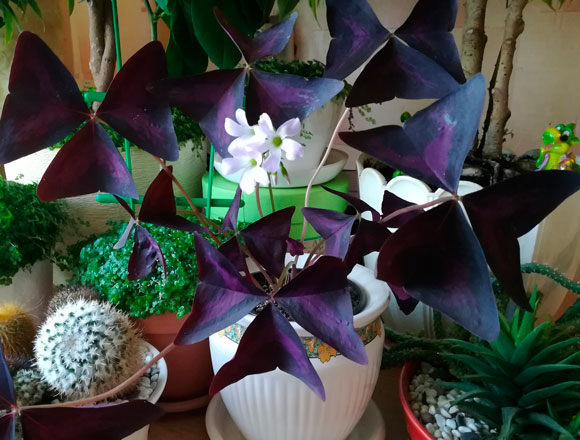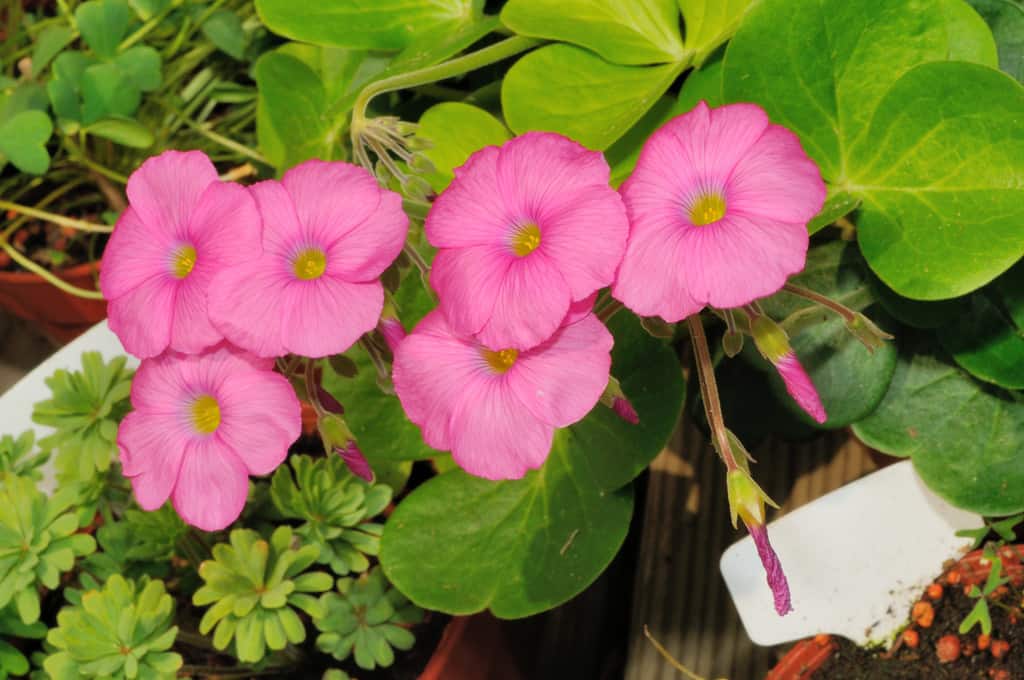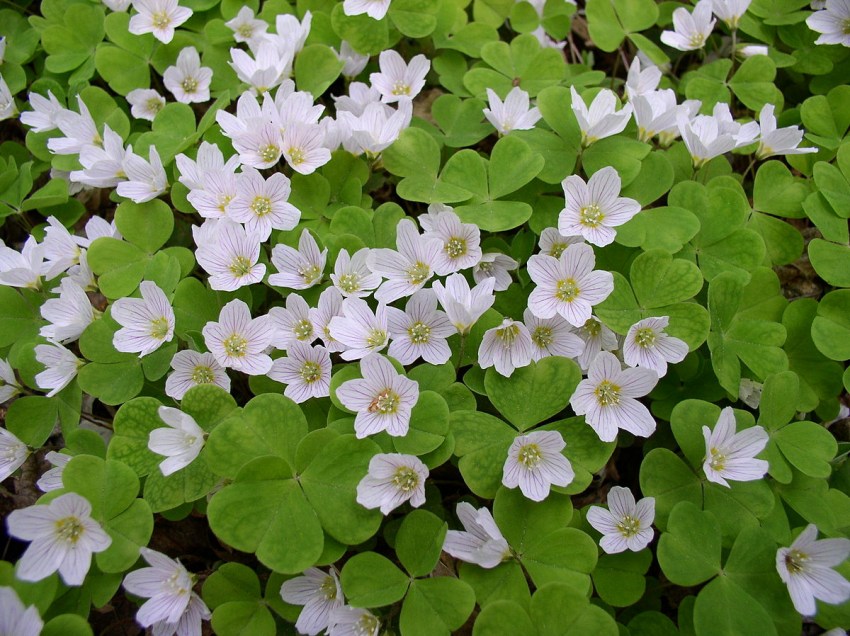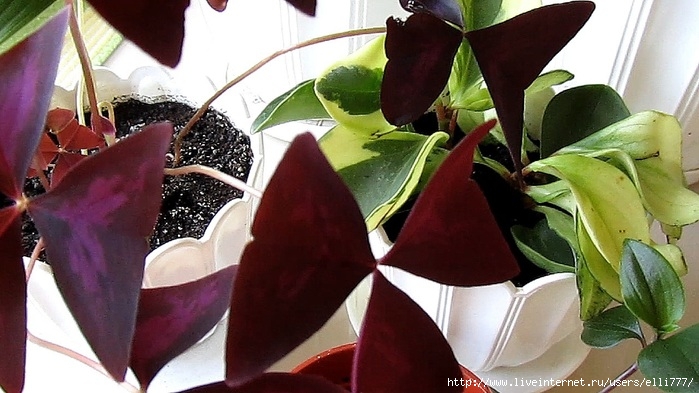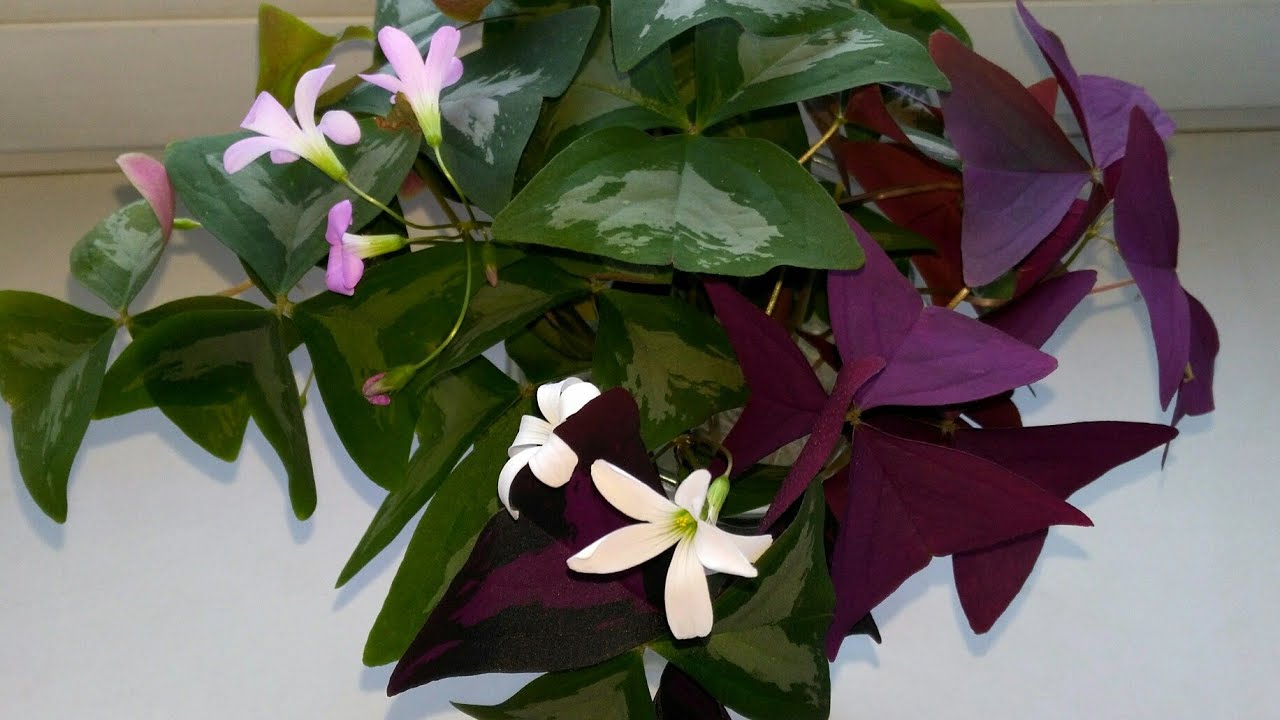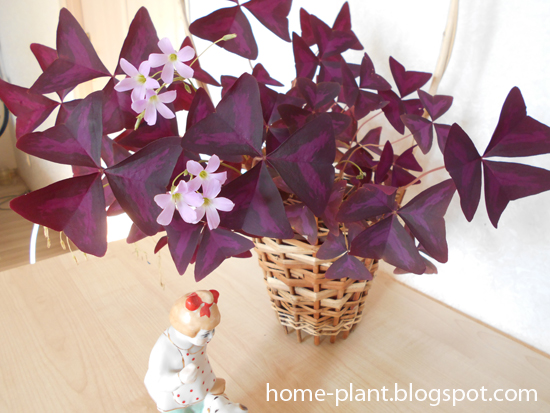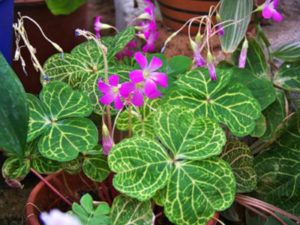Properties and types of plants
We recommend that you familiarize yourself
Oxalis in homes is grown mainly for its decorative properties. Although it is also considered a medicinal plant. In the old days, it was even used as an antidote for poisoning with mercury and arsenic, but you should not check its properties on yourself. In addition, in folk medicine, it is used as an anti-inflammatory and wound healing agent, and this is the case when science confirms the experience of use.
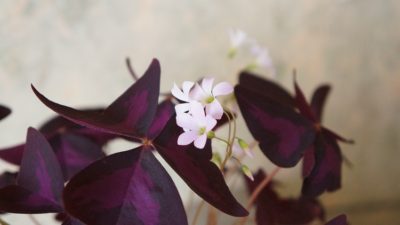
Herbal tea was prepared from acidic sour, it was added to green borscht. Indeed, it was believed that it gives strength, so you need to use it more. Today it has been proven that oxalis (and this is the scientific name of acid) contains a lot of vitamin C, which determined its properties.
In a room culture, such a type of plant as purple oxalis is often grown (it is also called triangular - because of the characteristic shape of dark purple leaves, resembling butterfly wings and having very interesting properties). This species has small and unremarkable flowers, usually pale lilac or pink in color. Violet oxalis reacts to lighting: in cloudy weather, when there is little natural light, or with the onset of dusk, its leaves fold like the wings of butterflies. In the morning or when the weather clears up, the leaves open again.
In phytodesign, this plant is often combined with various types of cyclamen, pelargonium, phalaenopsis orchid.
Another popular type is four-leaved oxalis, aka Depp's oxalis. It is distinguished by beautiful four-lobed leaves, which have a pleasant light green color with a reddish center. Among the people, this variety received other names, for example, "lucky clover" (there is also a more prosaic one - "iron cross" for its resemblance to the award of the same name). This type of oxalis is grown not only in rooms, but also in flower beds and in a rock garden.

Bowie's oxalis blooms beautifully with its long peduncles and elegant dark pink flowers. But the requirements for lighting and conditions are higher for this species. This is a thermophilic variety, rather fragile, requiring special care. Spectacular flowers bloom on ferruginous acid. She has interesting multi-lobed leaves, and the flowers are eye-catching with multi-colored veins on a white background. The multicolored oxalis looks even more impressive. It is decorated with white flowers with a wide red border along the edge of each petal. The listed species are grown mainly in the garden, but they can also take root on the windowsill.
How to take care of Oxalis during the rest period.
I do not water the acid during the rest period and move it to a dark and cool room.
First of all, you need to understand that different varieties of Kislitsa have different periods of rest. For example, Kislitsa Orgtis has a rest period - all three winter months, while Kislitsa Deppe has a period of rest - from December to January. Throughout the rest period, Oxalis is watered very rarely, or not watered at all. If Kislitsa simply stopped growing and its leaves drooped, then it can be watered occasionally, but if it has dropped the leaves, then do not water it until it wakes up. We advise you not to water anyway. It is best to remove Kislitsa in a cool and dark room, where there are no temperature drops with a constant temperature of +14 degrees.
Important! It is very easy to understand that Kislitsa woke up - you will see how new shoots begin to develop. At this time, Oxalis can be returned to its usual place to resume watering.
Home flower oxalis. Reproduction
How does it multiply
There is a lot of writing on the Internet about how this houseplant reproduces. There are many options - and nodules, and cuttings, and seeds. I have never tried the last methods, but it is easy to do it with tubers.
And you can try to propagate the flower by cuttings, this is done as usual. We put the cutting in water, and after the appearance of the first roots, transplant it into soil or sand, where further rooting will take place.
Each tuber can have one, two leaves, but do not worry if they break off or the tuber is left without small roots. Plant him in the ground, he will definitely take over, let leaves and color, and new nodules will grow around very quickly.
How to transplant
When transplanting acid, it is better to plant it, since it grows rather quickly. You can put five or ten nodules in one pot, keeping a distance of 10 cm between them, although sometimes I put them thicker. It is not necessary to pour a lot of earth on top, just a little, about 0.5-1 cm.
When to transplant
As for any home plant, the best time for transplanting is spring, and when asked how often this should be done, I will say that every two to three years. Although you will see for yourself when the oxalis needs a transplant. Instead of a beautiful lush bush, there will be rare single leaves, flowering will stop, it is clear to the naked eye - the flower is bad.
In which pot to plant a flower sour
Let's start with which pot to plant the sour flower in. It should not be very deep, since the root system of the plant is weak and goes shallow into the ground, but on the other hand, the pot must be chosen so high that the hanging leaves do not lie on the windowsill.
Oxalis looks very beautiful not only in round pots, but also in long rectangular or oval ones. Several nodules are planted in them in one row. After the growth of the bushes, the view is simply mesmerizing.
What kind of soil to use
For the umpteenth time I say that the plant is not capricious, so the soil is suitable and universal, the main thing is that it is not too nutritious, otherwise there will be a lot of leaves, but no flowers. Be sure to make a drainage layer of expanded clay.
Here is such an indoor oxalis flower. The photo showed you what kind of care he needed and told about reproduction too. I wish you good luck with this wonderful plant, may it please you with its beautiful appearance and flowering.
Oxalis home care
Successful growth, luxurious flowering and a wonderful view of the clover of happiness are guaranteed by correctly fulfilled conditions of maintenance: lighting, thermal regime, correct watering, suitable soil. Even an inexperienced flower lover can have a wonderful plant "Madame Butterfly". Let's get acquainted with the rules of care in more detail.
Site selection and temperature conditions
Attention! The light should be intense and diffused. The best option would be to place oxalis on the windowsill from the east or west direction
In the morning, the flower of happiness will enjoy direct sunlight with pleasure.
The best option would be to place oxalis on the windowsill from the east or west. In the morning, the flower of happiness will enjoy direct sunlight with pleasure.
The flower, day and night, will be happy to be content with moderate temperature indicators in the summer of about 18-25˚С, and in the winter period 15-18˚С. To obtain a gorgeous flowering, we reduce the winter temperature regime to 10 ° C, but not lower.
Important! Protect your false clover from drafts
Air humidity and watering
A flower day and night can be perfectly satisfied with normal air humidity and even with dry air it will be comfortable. There will be no room oxalis from spraying with a spray gun or placing it in a pan with wet pebbles.
During the period of active growth, we water abundantly with settled warm water, avoiding stagnation of water in the flowerpot.The soil between waterings should dry out to a depth of one and a half centimeters. In the fall, watering is less frequent, and by winter, watering is still minimized.
Soil and its fertilization
Oxalis, which is not demanding on the soil, can be limited to a universal mixture from a flower shop or light fertile soil for violets. For self-preparation of the substrate, it is necessary to take in equal shares sod, leaf, peat soil and sand.
To feed your "Madame Butterfly" during the growing season you need a complex mineral fertilizer intended for flowering plants. The acid berry will be satisfied with half the fertilization rate at an acceptable interval of twenty days.
Oxalis transplant
A young indoor oxalis wants a spring transplant every year, an older plant in terms of filling the flowerpot with tubers - with an interval of three years. Good drainage is needed at the bottom of a wide pot.
Important! Having transplanted your flower of happiness, do not be lazy to loosen the earth in a flowerpot
Oxalis reproduction
Propagate oxalis by simply dividing the plant during transplant.
It is not difficult to get a new plant with tubers. You need to plant them in pots with a family of up to ten pieces, sprinkle them with one centimeter of soil and in a month you can already see the result.
Leafy cuttings can be rooted in water or sand in the spring, and then a few leaves can be planted in a separate flowerpot.
Seeds that have fallen to the surface of moist soil also reproduce well.
Pests and diseases
Oxalis home care is considered in detail. It can be concluded that the plant has strong immunity. And when the growing conditions are met, the flower will practically not hurt. So that the oxalis is not attacked by uninvited guests, you must periodically admire and examine your beauty. If you suddenly appear aphid, scale insect, tick, whitefly, mealybug, you must immediately use insecticidal preparations.
Difficult moments of growing
- Oxalis leaves turned yellow - the soil is too waterlogged, perhaps there is little or no drainage.
- Oxalis grows slowly - the temperature in the room is above 27˚С, the soil is drying out.
- Leaf plates drooped and lost elasticity - insufficient watering.
- The clover of happiness stretched out and became loose, the flowering is very poor, and the leaf plates turn pale - there is not enough lighting for the plant.
Oxalis signs and superstitions. Oxalis benefits and harms.
It will be interesting for amateur flower growers who believe in omens to know that only signs of a positive nature are associated with a butterfly flower.
A beautiful and unique plant, the flower of happiness, brings comfort, peace, health and well-being to the house. A friendly and calm atmosphere is maintained in the houses where this unique one grows.
To attract good luck and luck, prosperity, purchase oxalis. It will help you find a soul mate, get rid of a depressive state, improve your mood and raise your vitality.
Give your spectacular pet more attention, love and he will give you a huge amount of joyful minutes.
How to propagate the oxalis plant correctly
Acid should be propagated using seeds in the spring. Seeds are planted in wet peat or perlite. Cover the pot with plants with a plastic bag, secure with an elastic band. Place the flower in an environment where there is indirect sunlight. Fresh seeds try to germinate quickly. Once they are germinated, they are transplanted into a normal soil mixture into a normal pot.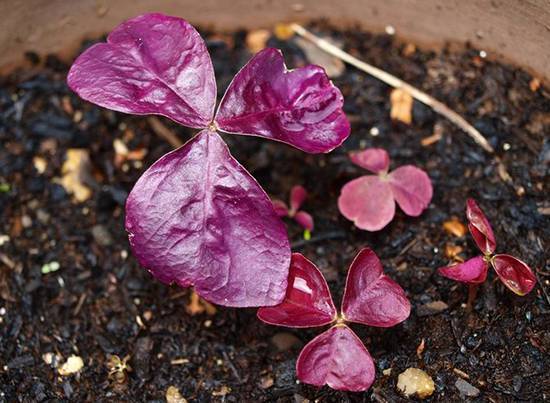
The seeds of the acid plant sprout The plant should also be propagated with tubers, which should be planted in October or February - March to a depth of one centimeter.
Dividing the acid bush Oxalis can be propagated by means of leaf cuttings.Separately, leaves with petioles germinate in water or sand; in spring, root systems can form quite quickly. A few leaves will be planted in a pot.
Oxalis triangular, or violet oxalis (Oxalis triangularis)
Room violet oxalis (in Latin Oxalis triangularis) is a herbaceous perennial, belongs to the Sislichnye family. An escapade from the southern regions of America and Africa was named in Russia as a butterfly flower; oxalis is popular with summer residents, thanks to its useful qualities.

Triangular oxalis
The plant is responsible for cleaning the air from toxins, heals and strengthens the body. The flower is placed indoors by those who want to heal faster and stay in good physical shape. Placing a plant in the office on the desktop or in the bedroom will help the owner to understand his vocation correctly.
Violet edible oxalis is suitable for human consumption. It is used for treatment in alternative medicine.
The overseas newcomer has become an adornment of window sills since the last century. The plant is striking with triangular leaves and intense purple color. In addition, on the sheet plates, strokes and spots of a different color are easily distinguished.
Attention! This species has a green color, which is striking in its decorativeness and elegance. Small white flowers will delight almost all year round
Common oxalis (Oxalis Acetosella)
The foliage of Oxalis acetosella is tripartite, in some varieties - with 4 halves.
The sorrel flower is characterized by a circular arrangement of petals on thin shoots, low above the soil and similarity to the wings of butterflies. The stalks are collected in a bush. The abundance of shoots gives splendor. The sorrel of a home flower has a dark green or purple color. Plant height is limited to 30 cm.
Small flowers rise above the foliage. The popular varieties of oxalis ordinary have pale pink, snow-white or lilac buds.
Additional Information. Various beliefs are associated with the sour plant. It is believed that a flower for Christmas is the best gift for friends and family (brings prosperity and success).
The peak of decorativeness of perennial culture falls in the spring and the arrival of the summer season.
Four-leaved oxalis
Kislitsa four-leafed is considered a highly decorative culture. In common people it is called a flower of happiness, a false shamrock.
Florists grow Depp's Oxalis Iron Cross as a pot culture.
A characteristic feature of Depp's sorrel is burgundy spots in the middle of the leaf plate, hence the name of the plant - an iron cross.

Oxalis Depp Iron Cross
The original structure of the leaf plate resembles a clover. Oxalis is used in landscape design. They are ideally suited for cultivation in unprotected soil as a ground cover crop in rocky gardens and carpet flower beds.
Perennial blooms for a long time. The inflorescences have a red-crimson tone. In foggy Albion, they call it the lucky clover.
Carob oxalis
The herbaceous perennial crop reaches 40 cm in height. Thin creeping shoots release, upon contact with the soil, roots in the leaf nodes, which are slightly pubescent. Composite leaves of Oxalis Corniculata include 3 cordate segments. The length of the petioles is 1-7 cm.
Erect thin peduncles of Rozhkova's sorrel bear from 1 to 5 yellow-golden cup-shaped buds with 5 long petals at the top. The color palette of foliage contains shades of greenish, burgundy, lilac, brown.
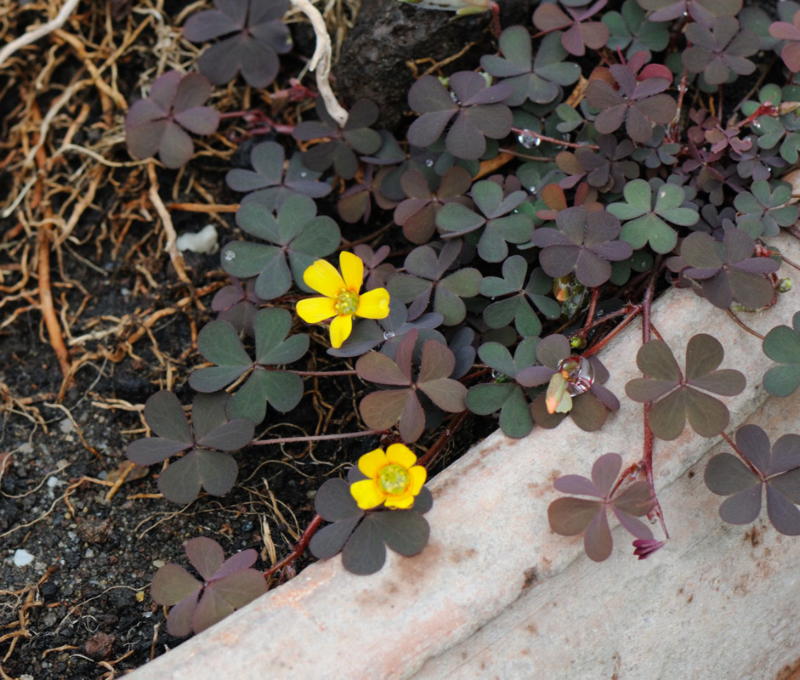
Carob oxalis is not only a decoration, but also a weed in the garden
Carob oxalis reproduces aggressively, therefore its development is often restrained and fought like a weed.
Kislitsa Ortgis
The height of herbaceous acid with erect thick stems of burgundy color varies in the range of 15-30 cm. The leaves of Oxalis ortgiesii are complex, thin long petioles include 3 leafy parts that resemble a fish tail in shape.Sheets with pubescence and gloss, branched veins, color - green-bluish or green. Leafless peduncles end in yellowish, funnel-shaped flowers with 5 petals.
The dormant period at the sour
Certain varieties of kislitsa have a pronounced dormant period, requiring a maximum temperature of +14 ° C in winter.
Attention! Oxalis varieties differ in periods of rest: Orgtis's oxalis - completely winter season, Depp's oxalis - from December to January.
During this period, the flower is rarely watered or not watered at all. Cessation of growth and drooping leaves indicate that the plant needs watering. Dumping foliage means that you need to stop watering until the oxalis wakes up. The acid is removed in a cool and dark room, where there are no temperature jumps (+14 ° C). New shoots signal the awakening of the plant, followed by the resumption of watering and return to the old place.
Oxalis flower is taken out to the garden in the spring and summer in order to decorate the landscape with potted plants.

Oxalis in landscape design
In May, the garden sour cherry is planted in open ground, after a month or one and a half, the culture will take root and begin to bloom. It is advisable to pick up the beds so that the direct light of the sun does not fall on the plant.
In October, the plant must be dug out - it will not tolerate frost. This refers to the Martian oxalis, a seasonal crop. The bulbs for the winter will have to be removed after the foliage dies, with the onset of spring, plant again and admire the beauty.
Additional Information. Sometimes alpine mountaineer (Zlatoust sour cherry) is confused with hare cabbage. Plants belong to different families: the first - to Buckwheat (it is a honey plant), the second - to Kislichny plants.
When cultivating an amazing plant - sour cherry, care at home is not difficult. Delicate blooming almost all year round, she is not capricious about trifles, for a long time she pleases the owners of the house with her presence and delivers only positive emotions (love, happiness).
Necessary conditions for different types
The homeland of so many ornamental species of acid is hot countries, so such plants are suitable for growing on a windowsill, in a winter garden or a greenhouse. In the warm season, such oxalis can be taken outside, thereby decorating flower beds and a garden from May to October. Proper care will help the plant grow green mass faster. After the onset of cold weather, the bulbs are dug up and sent to storage, so that these attractive plants can be planted again with the arrival of heat.
The following types of sorrel are classified as thermophilic.
- Triangular. It is easily recognizable by its deep purple, lilac and crimson leaves and white flowers. This oxalis is grown mainly indoors, but in warm weather it can also be used to decorate the area around the house.
- Regnell. It has dark purple leaves (about 2 cm long). She usually decorates window sills, but in the summer she does not mind being taken out into the street. It does not tolerate high temperatures, so in the heat it is better to put it in partial shade or a cool place. The ideal option would be to decorate the soil around large garden trees, which will protect the plant from the scorching sun rays. There are varieties of sour Regnell with green leaves.
- Purple. Originally from South Africa. This oxalis has large green drooping leaves (their diameter is 7 cm) and bright pink or snow-white flowers. Will be a great decoration for paths and rocky props. Looks great on an alpine slide.
But there are also frost-resistant types of acid, which do not require special care. They easily tolerate cold outdoors.
- Carob oxalis, which has brown cherry leaves and small yellow flowers of little interest. It is known to many as a weed, therefore, flower growers, despite the decorative foliage of this species, are wary of it.Its growth must be carefully controlled. If you neglect reproduction from sight, then this oxalis will soon fill the entire flower garden and the beds in the neighborhood, and even penetrate the territory of the neighbors.
- Iron-leaved. This oxalis looks very impressive in the garden. Its voluminous leaves have an unusual shape, because they consist of many oval lobes. Flowers with a silvery color with spots and edging are no less pretty.
- Common, and its popular variety Var. Subpurpurascens, forms a dense carpet decorated with pink flowers. Cold hardy, blooms mainly in May and June.

Sour original shamrock - clover of happiness
Kislitsa or oxalis is not even the last in the Kislichnye family. Eight hundred varieties of various oxalis have united in this genus herbaceous, both annuals and perennials.
The southern part of the African continent, Central and South America, can be considered the native territories for the oxalis; Central Europe also became home to some species of oxalis.
In the scientific field, the name oxalis (oxalis), which is directly related to the Greek word "oxis". It can be translated - sour. In fact, the leaves of the flower have a sour taste. Even the use of leaves in food will not bring harm to health. The plant contains oxalic acid.
Europeans call the oxalis flower "clover of happiness" or false clover for the similarity of leaf plates with clover leaves, and in the CIS countries the oxalis plant has its own name - "hare cabbage". There are many other popular names for oxalis - false clover, "Madame Butterfly", butterfly flower, happiness flower, day and night flower.
The oxalis flower was cultivated in the seventeenth century. Where does oxalis grow? It is often found and is an adornment of both gardens and rooms. High decorative qualities and modest requirements for cultivation have made the oxalis flower generally recognized by flower growers.
What does oxalis look like? She has a cool look. Oxalis oxalis has unique, beautiful trifoliate or palmate, petiolate leaves with a complex limb. In the mornings, the sheet plates are flat, straightened, and by the evening they fold in half. Room acid has a unique property to react to bright light and mechanical stimuli.
The color palette of the leaves is varied from green, purple to burgundy. Oxalis flowers are small, their configuration is correct, pleasing to the eye with white, pink, yellow or lilac shades. In the evenings or before the rain, like leaves, the flowers acquire a closed position. After flowering, seeds ripen in the shells, which flies abruptly with a slight touch.
Kislitsa photo can be viewed and learn more about each type of flower in the next section of the article.
Oxalis diseases and other growing problems
Leaf spot is a general term for several similar fungal diseases. Its main symptom is the appearance of red, purple-brown, brown or black spots on the leaves. Their size varies depending on the type of fungal spores. The leaves turn yellow and then fall.
Infectious chlorosis is common. Its symptom is yellowing caused by nutrient deficiencies. Also, the disease is characterized by the appearance of yellowish rings or stripes on the leaf plate, which eventually merge, darken, and the leaf itself dries up.
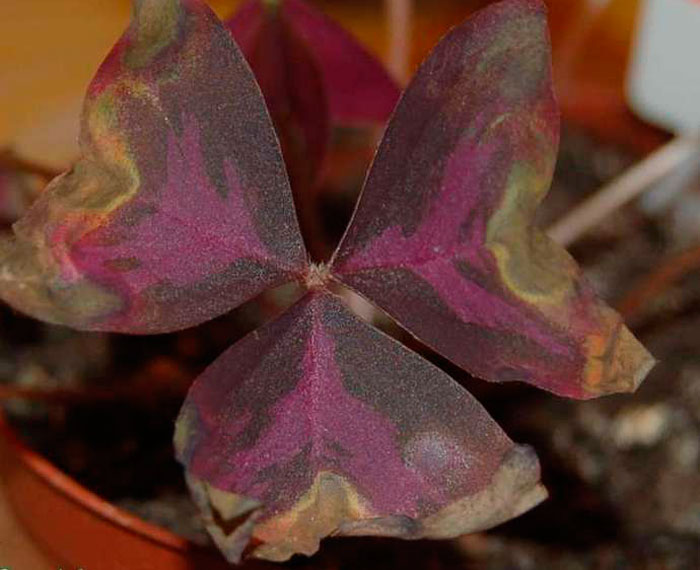
Leaf spot
Leaf rust is another fungal disease that is characterized by the appearance of yellow or yellowish orange spots and bumps.
Gray mold is a fungal infection that infects flowers, stems, and leaves of many plants, including purple sour.Symptoms can vary, but a common occurrence is a fuzzy, whitish-gray mold that grows on the surface of leaves and other affected parts. Small, yellow or brown spots appear on the leaf blades, which gradually increase. Infected stems become watery, soft and rot at soil level.
In most cases, problems can be solved by applying insecticides. In especially neglected situations, you will have to destroy the flower.
Note! Shriveled, mottled leaves are a sign that the problem is caused by too low temperatures. Of the pests, it can be affected by spider mites, which are destroyed with the help of insecticides
Of the pests, spider mites can be affected, which are destroyed with the help of insecticides.
In the presence of weak cuttings with small leaves, you need to think about increasing the level of lighting, as well as possible excessive humidity. If the leaves lose their brightness, then you should choose a place with good light. When rhizomes, nodules and onions rot, you need to stop watering them often.
Indoor oxalis flower not only pleases the eye with its unusual leaves, similar to tropical butterflies, but is also quite suitable for eating. Caring for him is simple. In gratitude for it, the culture will bloom for a long time.
Diseases and pests
All diseases of oxalis are due to improper care. Excessive watering at low temperatures and underfilling in a hot room, untimely fertilization are the main reasons for the development of diseases and the death of a flower. When creating favorable conditions for the shrub, insect pests will not appear on it.
- At low humidity, a spider mite can settle on the plant. You can get rid of it with the help of insecticides.
- A mealy worm likes to settle in the axils of the foliage. It is removed with a cotton swab dipped in alcohol.
- With excessive watering, the flower develops gray rot or fusarium. Treatment for diseases consists in treatment with foundation. And also with an excess of moisture, foliage withers. There is one caveat: if a plant dries up and sheds foliage in winter, then this is a harbinger of the beginning of a dormant period, and not a disease.
- If there is a high temperature in the room, and the air humidity is low, the leaves of the acid plant wither. This can also happen if the plant is grown in full sun.
The soil
Oxalis is not too demanding on the soil. Loose, fertile, slightly acidic soil will do. You can buy a ready-made substrate for violets or decorative flowering plants.
For self-preparation of the mixture, you should take 2 parts of garden soil and deciduous humus and 1 part of sand and high peat. Another option is 2 parts of sod land and 1 part each of sand and leafy land.
It is important to disinfect the finished soil mixture for acidic acid by spilling it with a weak solution of potassium permanganate or keeping it in a preheated oven for 10-15 minutes. The pot is required with drain holes
Good drainage is essential. In its capacity, you can use clay shards, expanded clay, pieces of foam. This will help in the future to avoid stagnant water in the pot.
The pot is required with drain holes. Good drainage is essential. In its capacity, you can use clay shards, expanded clay, pieces of foam. This will help to avoid stagnant water in the pot in the future.


